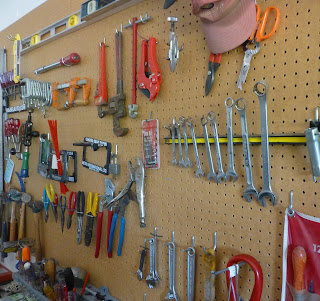New life comes from the old Peugeot
X-rays of my troubled right knee
show the doctor that it isn’t quite time yet. “Tone up the muscles.
Stretch. Do some
non-impactful exercises. Go to the
gym and ride the stationary bike.”
“I have a stationary bike,” I reply. So I make a commitment to go out on the
back patio and ride the thing ten to twenty minutes a day just after rising in
the morning. My commitment lasts
less than a Middle Eastern cease-fire.
Why? Boring. The view of the back fence from the
patio never changes. I guess I’ll
just settle for a bum knee.
Rummaging around my garage, I
frequently move my old Peugeot ten-speed because it’s always in the way. If I move it from in front of the
shelves, it’s blocks the workbench.
If I move it away from the workbench, it blocks the door. Some times I just lean it up against
the side of the house. If it
weren’t for the sentimental value, I often think, I’d donate the damned thing
to the nearest charity.
Then recently, as I’m rolling the bicycle out of my way to
access a shelved box of nails or screws, an inkling inkles: Riding the old ten-speed
around the neighborhood and into town, might be just as beneficial and
non-impactful an exercise as cranking on the stationary bike for ten minutes at
a time. And the view would change.
I pump up the gum-walled tires and hop aboard.
Our neighborhood is relatively flat,
but on the Peugeot, even the slightest downhill is a rush. With no more than about fifteen turns
of the crank, I’m a mile from home passing the coffee bar, not breaking a sweat
and my knee feels great!
Three or four cyclists are there, outfitted in form-fitting
pants, garish cycle-centric nylo-fiber shirts with big empty front and back
pockets and velo-ads plastered all over them, and helmets.
Even though my cargo shorts and ball cap headgear looks as
if I just stepped off a road grader or out of a retirement neighborhood, I stop
for a cup of dark roast. One of
the fellows says, “I used to have one
of those,” pointing to the bike I’ve had since college. After me not contributing to their
conversation about their latest “run out to the coast (66 miles),” I mount up
and head home.
Did I say we lived in a relatively flat community? The four-minute glide into town is a
fifteen-minute grind back into the neighborhood. Rusty in my use of the derailleur, the chain stutters and
jerks as I search for the ratio that will allow me to pump my way back home. I concentrate on staying on the seat as
opposed to falling forward onto the steel crossbar that looks – from directly
above – menacingly similar to one I painfully recall from a very early incident
of my bicycling youth. Finally, I
reach our driveway, gently touching the toe of my shoe to the ground. I wait there straddling the seat, while
my breath catches up with me. It
seems it was about a block and a half behind on the final climb to the house.
Yet, the following day, I do it again, modifying my route
and lengthening it a bit. I want
to check the construction progress on the new Renner gas station going in just
south of town. I decide to pick
one gear and stay in it whether I’m whizzing along a flat stretch of road or
pushing myself to get up the hill. I don’t stop for coffee. I do twenty minutes.
On the third day, I add a bit more and tackle the hill that
fronts the Hamburger Ranch Barbecue joint. I enjoy that becoming-familiar rush by coasting down the
other side past storefronts and into town.
I’ve ridden the old Peugeot on a daily
basis for longer than the most recent, ill-fated Syrian cease-fire lasted. I’m up to between thirty and forty
minutes, exploring neighborhoods and country roads, viewing hillside vineyards,
paralleling the old railroad line and using the paved path next to the Russian
River that we’ve walked many times.
I’m packing my camera now. The scenery is much better than the view of my back
fence.
The other day, I saw an old Ford Ferguson tractor rusting in
somebody’s front yard. It was like
the one upon which I learned to drive.
There’s a great “stairway to heaven” leading up to the
oldest part of the town cemetery.
And the Northwestern Pacific right-of-way has all manner of
eighty-year-old railroad memorabilia and clutter.
My knee is wrapped and on ice as I type. And as I type, I plan tomorrow’s little
itinerary.
© 2016
Church of the Open Road Press















































